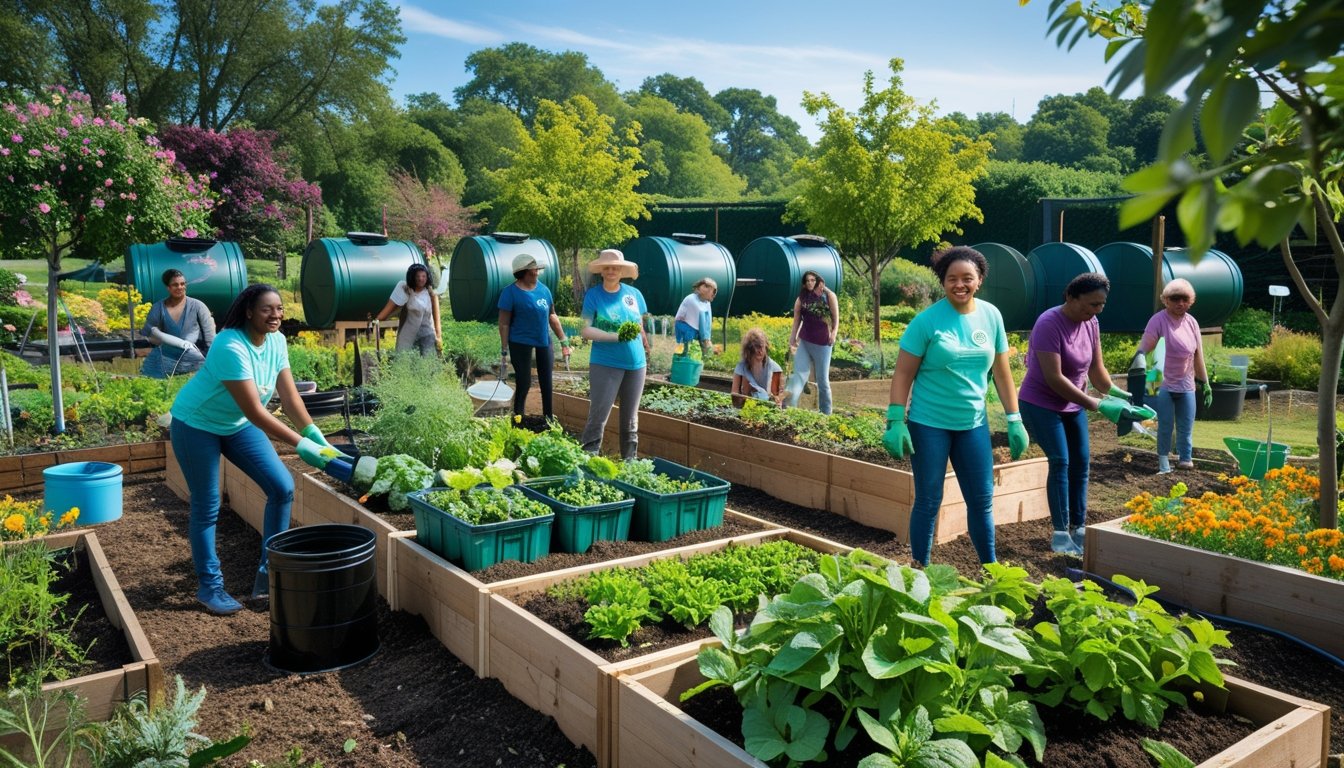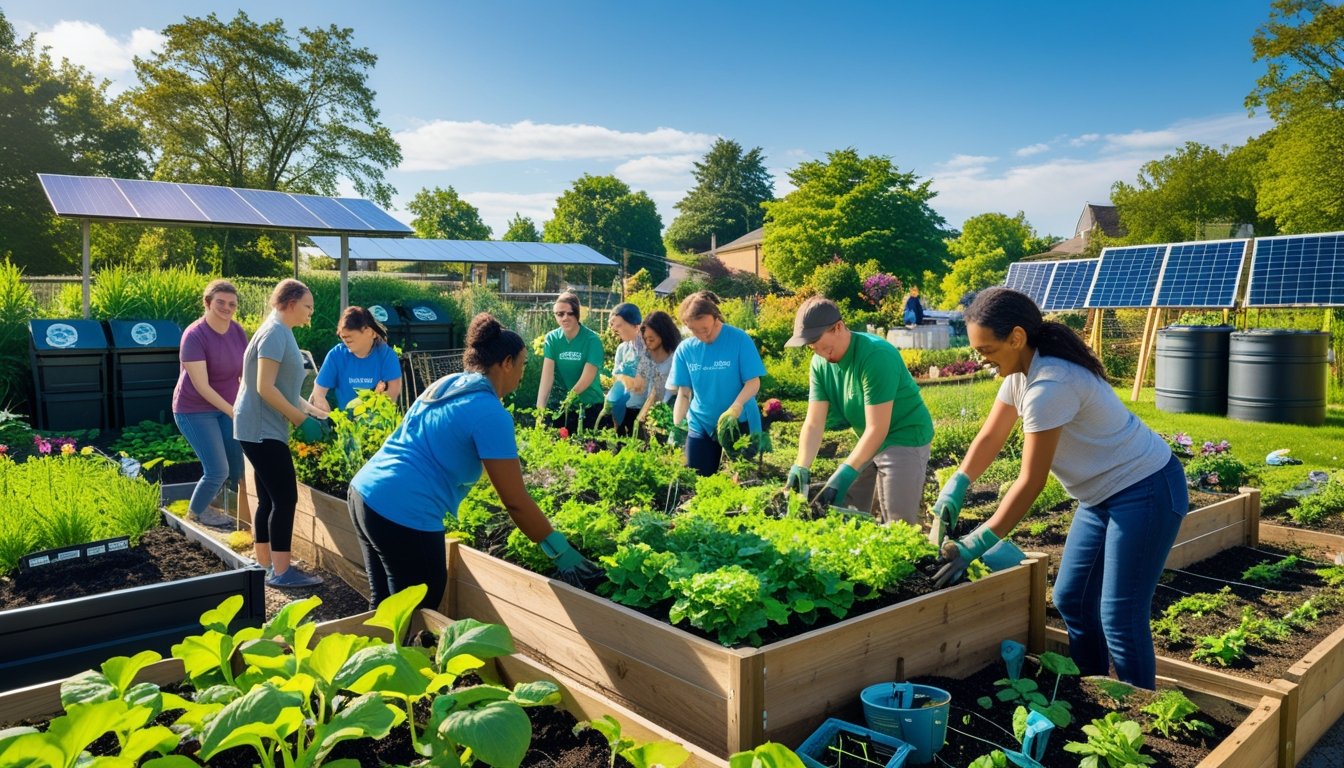Late updated: 14 Aug 2025 12:08
Written by: Sarah Hollister
Tips For Starting An Eco-Friendly Community Garden: A Practical Guide
Starting an eco-friendly community garden is a rewarding way to merge environmental efforts with community engagement. By integrating sustainable practices, we can create vibrant green spaces that not only beautify our neighbourhoods but also contribute to environmental conservation. A well-planned community garden fosters biodiversity and reduces our ecological footprint while bringing people together for a shared cause.

Our journey into eco-friendly gardening begins with choosing plants that thrive in local conditions and employing strategies such as composting and natural pest management. These methods ensure our garden remains sustainable and productive throughout the seasons. It's crucial to design our garden layout thoughtfully, taking advantage of resources like rainwater harvesting and recycled materials.
Engaging community members is vital to the success of our garden. By organising events and workshops, we can build a supportive network of garden enthusiasts committed to sustainable practices. This collaboration not only strengthens community bonds but also ensures that all members can enjoy fresh produce and the beauty of nature in their own backyards.
Key Takeaways
- Prioritise sustainable practices to maintain an eco-friendly garden.
- Engage the community for a thriving and inclusive gardening experience.
- Implement sustainable strategies to maximise environmental benefits.
Essential Steps for Starting an Eco-Friendly Community Garden
Creating an eco-friendly community garden involves strategic planning to foster local partnerships, selecting an appropriate site, and designing sustainable garden layouts. Collaboration is key, along with utilising resources wisely to ensure success.
Building Community Support and Partnerships
Establishing a community garden begins with securing community support. We must engage with local residents, businesses, schools, and environmental organisations to build a robust network. Hosting informational meetings or social gatherings can help raise awareness and generate interest.
Local businesses can offer sponsorship or supplies, while schools might provide volunteers or educational opportunities. Collaborating with environmental organisations can further enhance our garden's eco-friendliness by engaging in practices that benefit biodiversity. Social media plays a pivotal role here, providing a platform to share progress, organise events, and recruit volunteers.
Selecting and Preparing the Site
Selecting the right location for our community garden is crucial. We should focus on vacant lots or other unused spaces that have good exposure to sunlight and suitable soil quality. It’s essential to conduct soil tests to determine nutrient levels and check for possible contaminants. This ensures that crops can thrive and are safe for consumption.
Proper site preparation involves clearing debris, enhancing soil quality with organic compost, and ensuring adequate drainage. A well-prepared site sets a firm foundation for a sustainable garden and boosts plant growth. Soil amendment with organic matter can significantly improve fertility, while mulching can help conserve moisture and suppress weeds.
Designing an Eco-Conscious Garden Layout
Designing the garden layout with an eco-friendly approach involves thoughtful planning. We must consider incorporating raised beds to improve drainage and extend the growing season. These beds can reduce soil compaction and improve accessibility, which is particularly beneficial for individuals with mobility issues.
Pathways should be designed to promote efficient movement while preserving the surrounding soil structure. Using permeable materials like gravel or wood chips helps with water absorption and prevents erosion. It's wise to include a mixture of native plants to attract pollinators, promoting biodiversity and ecological balance. With a focus on sustainability, our garden can thrive and contribute positively to the local ecosystem.
Sustainable Gardening Practices and Community Engagement

Engaging in sustainable gardening practices not only enriches the environment but also fosters stronger community ties. By integrating water conservation methods, enriching soil health, choosing suitable plants, and promoting community education, we can ensure that our community gardens thrive.
Water Conservation and Eco-Friendly Irrigation
To conserve water effectively, we should employ techniques like drip irrigation. This system ensures water is delivered directly to the roots, minimising waste. Collecting rainwater in barrels can also provide a sustainable water source. Weeding regularly helps reduce water competition, so plants receive the moisture they need. Additionally, mulching retains soil moisture and reduces evaporation. We need to be mindful of the timing of our watering, opting for early mornings or late evenings to maximise efficiency.
Soil Health, Composting, and Biodiversity
Healthy soil is the backbone of a thriving garden. Implementing composting practices enriches the soil with nutrients, reducing the need for chemical fertilisers. By adding kitchen waste and garden clippings to compost bins, we can create rich, organic matter that boosts soil health. Introducing crop rotation helps to prevent soil exhaustion and reduce pests. Encouraging biodiversity by incorporating various plant species supports a balanced ecosystem. Native plants, in particular, enhance soil structure and fertility without requiring excessive inputs.
Plant Selection and Pollinator Support
Selecting the right plants is crucial for a garden’s success. Native plants are well-adapted to local conditions and often require less maintenance. Incorporating pollinator-friendly plants such as wildflowers and certain herbs can attract essential species like bees and butterflies, crucial for fertilisation. Growing a diverse range of vegetables, fruits, and other edible plants ensures that our garden remains productive while supporting wildlife. Regular harvesting encourages growth and deters plant diseases.
Education, Events, and Long-Term Involvement
Community engagement is vital for sustainability. Hosting educational programmes and workshops on eco-friendly gardening practices can empower gardeners of all ages, promoting intergenerational learning. Organising events like harvest festivals can celebrate achievements and entries for fresh produce competitions. Long-term involvement is encouraged through regular events and clear communication, reinforcing community spirit and sustaining the garden's development. We should strive to make our community gardens an educational resource, providing continual learning opportunities for everyone involved.
Frequently Asked Questions

Creating an eco-friendly community garden involves careful planning, waste management, water conservation, and community involvement. It requires choosing sustainable plants and securing funding as well. Each aspect contributes to the garden's success.
What are the essential steps to initiate a sustainable community garden?
Start by choosing the right location, focusing on accessibility and sunlight. Partner with local organisations to gather resources and support. Develop a clear plan, including design, member responsibilities, and management practices. Secure necessary permits and begin building the garden infrastructure.
How can one effectively manage waste and composting in a community garden?
Utilise composting techniques to recycle organic waste into nourishing soil. Set up dedicated compost bins within the garden for members to use. Educate garden members on what materials can be composted and promote regular maintenance to ensure efficient decomposition.
What are the best practices for water conservation in community gardening?
Implement rainwater harvesting systems to maximise water use. Drip irrigation and mulching help retain soil moisture, reducing the need for frequent watering. Encourage members to water plants during cooler parts of the day to minimise evaporation.
Could you suggest a variety of plants that are more suitable for an eco-friendly community garden?
Choose native and drought-resistant plants. They adapt better to the local climate and require less water. Vegetables like carrots and beetroot, and flowers like lavender and sage, are excellent choices for sustainable gardens.
What funding options are available to support the creation of a community garden with an environmental focus?
Explore grants from environmental organisations and local government bodies. Community fundraisers or partnerships with local businesses can also provide financial support. Encourage members to contribute supplies or tools to ease the initial financial burden.
How can local communities be engaged and educated in the maintenance of an eco-friendly garden space?
Host workshops and tours to educate the community on eco-friendly gardening practices. Engage local schools for educational projects and involve residents in decision-making processes. Regular communication and events can keep the community motivated and invested in the garden's success.
